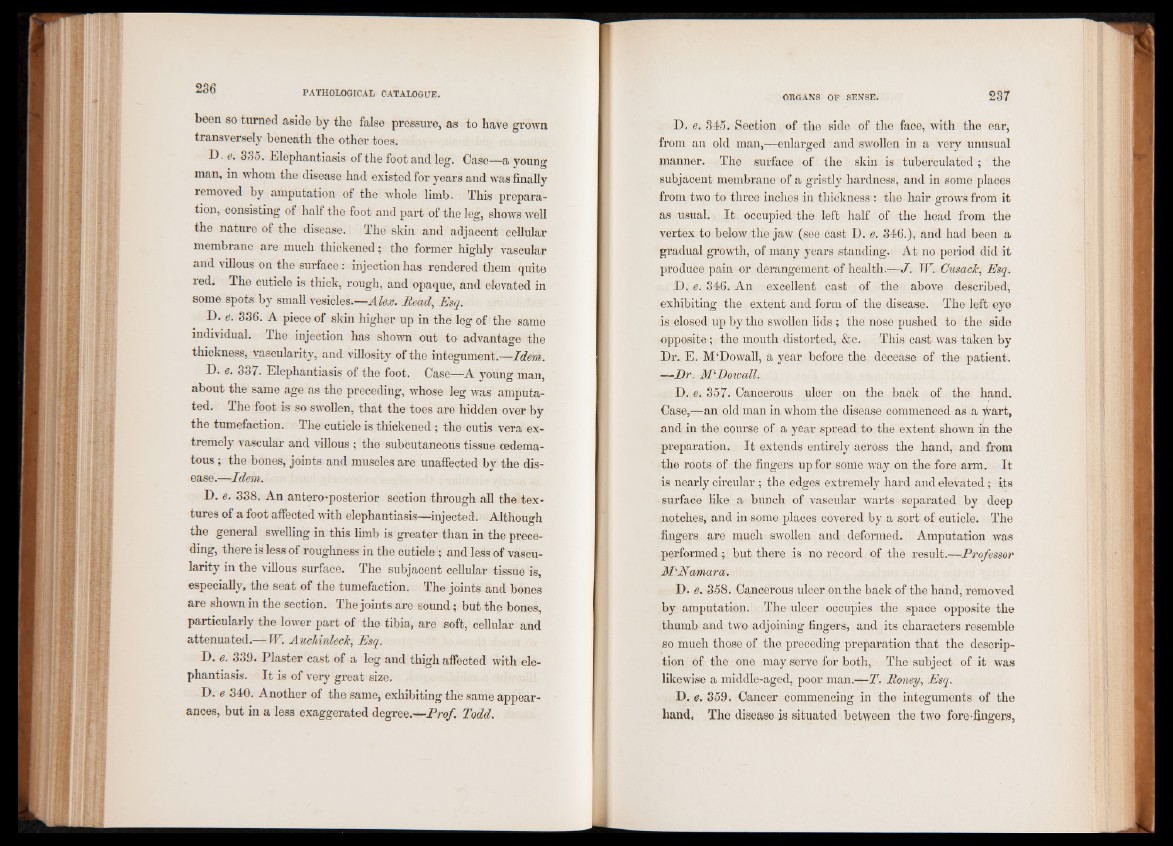
been so turned aside by the false pressure, as to have grown
transversely beneath the other toes.
D. e. 335. Elephantiasis of the foot and leg. Case—a youn^
man, in whom the disease had existed for years and was finally
removed by amputation of the whole limb. This preparation,
consisting of half the foot and part of the leg, shows well
the nature of the disease. The skin and adjacent cellular
membrane are much thickened; the former highly vascular
and villous on the surface: injection has rendered them quite
red. The cuticle is thick, rough, and opaque, and elevated in
some spots by small vesicles.—Alex. Bead, Esq.
D. e. 336. A piece of skin higher up in the leg of the same
individual. The injection has shown out to advantage the
thickness^ vascularity, and villosity of the integument.—Idem.
D. e. 337. Elephantiasis of the foot. Case—A young man,
about the same age as the preceding, whose leg was amputated.
The foot is so swollen, that the toes are hidden over by
the tumefaction. The cuticle is thickened ; the cutis vera extremely
vascular and villous ; the subcutaneous tissue cedema-
tous ; the bones, joints and muscles are unaffected by the disease.—
Idem.
D. e. 338. An antero-posterior section through all the textures
of a foot affected with elephantiasis—injected. Although
the general swelling in this limb is greater than in the preceding,
there is less of roughness in the cuticle ; and less of vascularity
in the villous surface. The subjacent cellular tissue is,
especially, the seat of the tumefaction. The joints and bones
are shown in the section. The joints are sound; but the bones,
particularly the lower part of the tibia, are soft, cellular and
attenuated.— W. AucUnlecJc, Esq.
D. e. 339. Plaster cast of a leg and thigh affected with elephantiasis.
It is of very great size.
D. e 340. Another of the same, exhibiting the same appearances,
but in a less exaggerated degree.—Prof. Todd.
D. e. 345. Section of the side of the face, with the ear,
from an old man,—enlarged and swollen in a very unusual
manner. The surface of the skin is tuberculated; the
subjacent membrane of a gristly hardness, and in some places
from two to three inches in thickness : the hair grows from it
as usual. It occupied the left half of the head from the
vertex to below the jaw (see cast D. e. 346.), and had been a
gradual growth, of many years standing. At no period did it
produce pain or derangement of health.—J. W. CusacJc, Esq.
D, e. 346. An excellent cast of the above described,
exhibiting the extent and form of the disease. The left eye
is closed up by the swollen lids ; the nose pushed to the side
opposite ; the mouth distorted, &c. This cast was taken by
Dr. E. M‘Dowall, a year before the decease of the patient.
—Dr. MlDowall.
D. e. 357. Cancerous ulcer on the back of the hand.
Case,—an old man in whom the disease commenced as a Wart,
and in the course of a year spread to the extent shown ifi the
preparation. It extends entirely across the hand, and from
the roots of the fingers up for some way on the fore arm. It
is nearly circular ; the edges extremely hard and elevated; its
surface like a bunch of vascular warts separated by deep
notches, and in some places covered by a sort of cuticle. The
fingers are much swollen and deformed. Amputation was
performed; but there is no record of the result.—Professor
McNamara.
D. e. 358. Cancerous ulcer on the back of the hand, removed
by amputation. The ulcer occupies the space opposite the
thumb and two adjoining fingers, and its characters resemble
so much those of the preceding preparation that the description
of the one may serve for both, The subject of it was
likewise a middle-aged, poor man.—T. Roney, Esq.
D. e. 359. Cancer commencing in the integuments of the
hand, The disease is situated between the two fore-fingers,